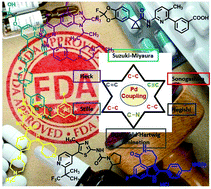Palladium catalyzed C–C and C–N bond forming reactions: an update on the synthesis of pharmaceuticals from 2015–2020
Abstract
Some of the most prominent and promising catalysts in organic synthesis for the requisite construction of C–C and C–N bonds are palladium (Pd) catalysts, which play a pivotal role in pharmaceutical and medicinal chemistry. Their wide range of selectivities, mild reaction conditions, and simple, efficient, and economical protocols make them desirable for the synthesis of highly functionalized molecules, medicinally important intermediates, pharmaceuticals, and agro-products. Researchers from academia and the pharmaceutical industry have also utilized a wide variety of Pd-catalysts for the synthesis of pharmaceuticals on a small and large scale. This review describes pharmaceuticals approved by the United States Food and Drug Administration (the U.S. FDA) between 2015 and 2020, which were synthesized via Pd-catalyzed cross-coupling reactions for the construction of carbon–carbon (C–C) and carbon–nitrogen (C–N) bonds. The review includes both medicinal chemistry routes and patented routes on a bulk scale. Along with details of the synthetic protocols of coupling reactions, the medicinal properties of each approved drug are discussed.

- This article is part of the themed collection: 2021 Organic Chemistry Frontiers Review-type Articles


 Please wait while we load your content...
Please wait while we load your content...